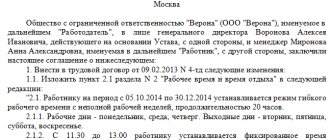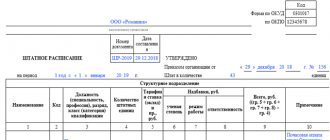Home / Labor Law / Payment and benefits / Wages
Back
Published: 04/07/2016
Reading time: 8 min
0
11396
Due to the nature of the work of some enterprises, they introduce a shift work schedule, in which employees work not one, but two or three shifts per day. This regime is appropriate, for example, for enterprises in which the duration of the production process is longer than the duration of work established by labor legislation. Also, several shifts can be introduced for more complete and efficient use of existing equipment.
In any of these cases, the question arises of how to properly organize the payment of employees and keep track of working hours. The rules and features of payment, as well as possible problems, are worth considering in more detail.
- Time tracking Daily
- Monday
- Summarized
- At a set hourly rate
The law allows you to work at night
Despite the fact that most organizations operate during the day, the specifics of certain types of work require night (and sometimes round-the-clock) operation. Just for such enterprises, there is a shift work schedule, according to which part of the shift or the entire shift falls during hours usually intended for sleep and rest.
The regulations for the organization and payment of such work are prescribed in Art. 96 and 154 of the Labor Code of the Russian Federation.
Is payment for night work included in wages in order to correlate it with the minimum wage?
How much to pay extra
Article 154 of the Labor Code of the Russian Federation stipulates that increased wages should be established at night. In the practice of enterprises, this is usually implemented through the payment of additional payment for night work. When such an additional payment appears as a separate line in the payroll, it will be convenient for OTIZ specialists to analyze the payroll by type of payment (read more about this in the article “Factor analysis of the wage fund”).
The specific amount of this additional payment should be determined by the employer himself. However, its size cannot be less than 20% of the salary and hourly tariff rate. This is determined by Decree of the Government of the Russian Federation dated July 22, 2008 No. 554.
Sometimes you can read in the comments to publications or hear opinions from lawyers that the Labor Code refers specifically to increased wages, and not additional pay for night time. This is interpreted in such a way that it is necessary to establish some special “night tariff rates”. However, the mechanism for implementing increased wages is not defined in the Labor Code, which means the employer can choose it independently.
The only limitation is that you cannot set bonuses for working at night (without paying an additional payment), since bonuses are considered incentive payments. And the additional payment for night work is a compensation payment.
Which shifts are considered night shifts?
The law declares night work hours to be from 10 p.m. (10 p.m.) to 6 a.m.
A shift will be considered a night shift if at least half of it consists of work within the specified time period. Payment at the night rate will be only for the hours that make up this period; the rest will be rewarded, as is customary in day shifts. The definition of “night shift” in this case is significant for deciding the issue of attracting or not attracting a certain category of employees.
ATTENTION! According to Art. 96 of the Labor Code of the Russian Federation, the night shift should be 1 hour shorter than the corresponding day shift.
The night shift is not reduced by an hour in certain special cases, namely:
- the employee was specifically hired for night work, and this is reflected in the employment contract;
- the employee has a reduced schedule;
- The shift schedule is based on a 6:1 scheme;
- when the shift cannot be shortened due to the nature of production.
Question: How to pay for overtime work at night when recording working hours with a long accounting period (for example, a quarter)? View answer
Piece wage system
Piece payment does not depend on the time worked and is applied to employees whose work results can be assessed in qualitative material indicators.
At the same time, the salary does not depend on the time worked, but working time must be kept track of: you need to fill out a timesheet. And when working at night, such employees are paid at increased rates.
Nowadays, in small enterprises, such a system is often used to pay those who work from home (freelancers) or part-time, with a flexible schedule. How to properly register such employees? The organization must keep time records, and freelancers must not work more than 40 hours a week. The company cannot control this on its own. But you can issue an order obliging the employee to fill out a time sheet, and make an entry in the employment contract stating that he determines the working hours and work schedule independently. At the same time, he should not work more than the norm for the production calendar.
Let us give two examples of such calculations.
Example 1. Piece payment for quantity
The daily quota of baked cakes from a confectionery employee is 5 pieces. The daily rate for the tariff is 1,500 rubles. In one month, the employee baked 94 cakes.
Payment for 1 cake will be: 1,500 rubles / 5 cakes = 300 rubles per piece.
In this case, the monthly earnings of a confectioner will be: 300 rubles × 94 cakes = 28,200 rubles.
Example 2. Piecework payment according to time standard
The bakery employee has a set time limit for baking one cake - 96 minutes. The hourly tariff rate is 187.5 rubles. The pastry chef baked 110 cakes in a month.
Piece payment will be: 187.5 × 96 minutes / 60 = 300 rubles/cake.
Monthly earnings will be: 300 × 110 = 33,000 rubles.
Documents on payment for night work
An enterprise must necessarily regulate the conditions for organizing and calculating remuneration for work outside normal hours. This should be implemented in the following local acts:
- in the regulations on wages (general or issued specifically for night hours);
- in the collective agreement (the opinion of the trade union body must be taken into account)
- in an employment contract with an individual employee;
- in the order to attract an employee to work at specified hours (if this is done one-time or an employee is attracted from a special contingent).
IMPORTANT! An order is necessary only in special cases; with a permanent schedule with night shifts, it is enough to fix the payment procedure in the Regulations.
conclusions
The technology for using a shift work schedule is reflected in the Labor Legislation of the Russian Federation. A feature of this technique is the high probability of overwork.
All of them must be paid accordingly. At the same time, the amount of total annual overtime work should not exceed a certain indicator.
This technology for arranging working hours is used in situations where it is necessary to ensure the uninterrupted operation of the enterprise. Almost employees of all factories and other organizations of a similar nature work in shifts.
The procedure for calculating wages when working in shifts depends on the established wage system. Calculation rules must be documented - in a local act, an employment contract.
Special contingent of personnel
Certain categories of employees do not have the right to work night shifts, without taking into account their opinion on this matter. Another list defines the circle of workers who can be involved in night work if they express their consent.
It is prohibited to work at night:
- women expecting a baby;
- minor workers, except for special categories provided for by the Labor Code of the Russian Federation and certain federal laws, for example, those involved in performances or other events.
You can work at night with written consent:
- mothers of young children (under 3 years old);
- disabled people of any group;
- employees who care for disabled people;
- workers caring for unhealthy family members (according to medical opinions);
- single parents with children under 5 years of age;
- guardians of children under 5 years of age.
FOR YOUR INFORMATION! An employee belonging to this category must be warned in writing that he has the right to refuse to work at night, and in turn, have his consent endorsed.
Factors determining the amount of pay for night shifts
The law establishes increased pay compared to daytime hours for each hour worked at night. The size of this increase depends on several important nuances:
- the minimum wage for night work established by the state;
- numbers set out in the relevant local act (usually the additional payment is a percentage of the daily salary or tariff);
- the number of night hours during which the employee was busy.
The amount of additional payment for each night hour of work cannot be less than a fifth of the regular daily salary (Article 154 of the Labor Code of the Russian Federation, Decree of the Government of the Russian Federation of July 22, 2008 No. 554).
NOTE! A shift schedule or a regular schedule is accepted in the organization; night hours are paid according to the same principle - with an additional payment.
How is overtime paid for during a shift work schedule?
According to Art. 152 of the Labor Code of the Russian Federation, payment for processing is made in the following order:
- the first 2 hours of activity - at one and a half times the rate;
- the rest of the time - in double.
Moreover, these coefficients are minimally determined by law. The final amounts of payment for processing are established by the internal documentation of the enterprise, i.e. they can be higher.
Important! When accounting for total hours worked, the additional payment for overtime is calculated as of the end of the reporting period. That is, if the reporting period in a company is a quarter and, based on its results, the worker has hours of overtime work: for the 1st month of the quarter - 2 hours, for the 2nd month - 1 hour and for the 3rd month - 1 hour, then all the time processing is summed up according to the rules of Art. 152 of the 4 hours of unscheduled work received in this way, 2 hours are paid at one and a half times the rate, the rest - at double.
To calculate the exact amount of additional payment for the overworked period, you need to know the specialist’s hourly tariff rate. If the employee’s salary is already calculated using tariff rates, finding out the amount of additional payment for overtime work will not be difficult. The situation is more complicated if the worker is given a monthly official salary.
There are several ways to calculate your hourly rate.
- By dividing the salary portion by the standard number of hours for 12 months. That is, with a salary of 30,000 rubles. monthly and standard working hours in 2021 at 1979 hours (with a 40-hour week), the hourly rate will be: 30,000 / (1979/12) = 181.91 rubles.
- By dividing the salary by the standard hours in the desired month. With a standard of 176 hours in October 2021, the hourly rate will be equal to: 30,000 / 168 = 170.45 rubles.
- When an enterprise uses summarized accounting of the period worked, the hourly rate can be calculated by dividing the salary by the average standard working hours in the reporting time. The norm in the 3rd quarter of 2021 is 528 working hours. Accordingly, the tariff rate will be equal to: 30,000 / (528/3) = 170.45 rubles.
Night on a business trip
If an employee must work at night while on a business trip, this does not change the mandatory additional payment. The only difference is that the employer is not obliged to pay extra for night hours spent on the way to the business trip, although he can do this on his own initiative and desire.
How is a flight paid at night if an employee returns from a business trip on a day off and the flight is partially carried out at night?
What if it's overtime?
It’s one thing when night hours are included in the work schedule, and a slightly different situation when they end up being worked beyond the norm, even with a shift schedule. How to make payment in such cases?
It is necessary to apply both the extra pay per night and the overtime factor, which is 1.5 for the first two hours of overtime and 2 for the subsequent time.
Examples of night wage calculations
Example 1. Payment for night hours with a fixed salary
Employee Polivanov K.I. with a salary of 25 thousand rubles. per month Works on a shift schedule 5 days a week (Monday to Friday). His evening shift is from 20:00 to 04:00. According to his schedule, he has 10 such shifts per month. The local act of the enterprise establishes a 20% share of additional payment for work outside normal hours. We will calculate the amount of the surcharge.
For the accounting month Polivanov K.I. fully worked the hourly quota corresponding to the production calendar (170 hours). Night hours each shift account for 6 hours (from 22:00 to 04:00), for a month this will be 6 x 10 = 60 hours. We need to find the average hourly tariff rate: 25,000 / 170 = 147 rubles. Let's calculate the amount of the night supplement for each hour: 147 x 0.2 = 29.4 rubles. For 60 odd hours you will need to pay an additional salary of 60 x 29.4 = 1,764 rubles.








